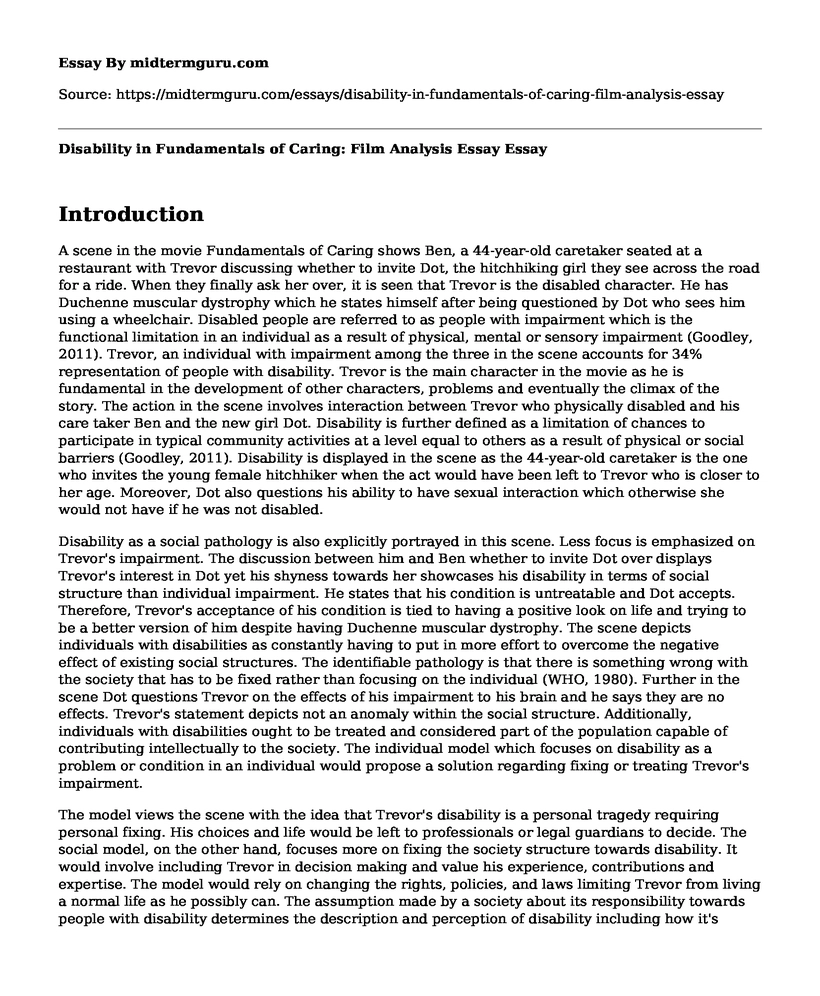Introduction
A scene in the movie Fundamentals of Caring shows Ben, a 44-year-old caretaker seated at a restaurant with Trevor discussing whether to invite Dot, the hitchhiking girl they see across the road for a ride. When they finally ask her over, it is seen that Trevor is the disabled character. He has Duchenne muscular dystrophy which he states himself after being questioned by Dot who sees him using a wheelchair. Disabled people are referred to as people with impairment which is the functional limitation in an individual as a result of physical, mental or sensory impairment (Goodley, 2011). Trevor, an individual with impairment among the three in the scene accounts for 34% representation of people with disability. Trevor is the main character in the movie as he is fundamental in the development of other characters, problems and eventually the climax of the story. The action in the scene involves interaction between Trevor who physically disabled and his care taker Ben and the new girl Dot. Disability is further defined as a limitation of chances to participate in typical community activities at a level equal to others as a result of physical or social barriers (Goodley, 2011). Disability is displayed in the scene as the 44-year-old caretaker is the one who invites the young female hitchhiker when the act would have been left to Trevor who is closer to her age. Moreover, Dot also questions his ability to have sexual interaction which otherwise she would not have if he was not disabled.
Disability as a social pathology is also explicitly portrayed in this scene. Less focus is emphasized on Trevor's impairment. The discussion between him and Ben whether to invite Dot over displays Trevor's interest in Dot yet his shyness towards her showcases his disability in terms of social structure than individual impairment. He states that his condition is untreatable and Dot accepts. Therefore, Trevor's acceptance of his condition is tied to having a positive look on life and trying to be a better version of him despite having Duchenne muscular dystrophy. The scene depicts individuals with disabilities as constantly having to put in more effort to overcome the negative effect of existing social structures. The identifiable pathology is that there is something wrong with the society that has to be fixed rather than focusing on the individual (WHO, 1980). Further in the scene Dot questions Trevor on the effects of his impairment to his brain and he says they are no effects. Trevor's statement depicts not an anomaly within the social structure. Additionally, individuals with disabilities ought to be treated and considered part of the population capable of contributing intellectually to the society. The individual model which focuses on disability as a problem or condition in an individual would propose a solution regarding fixing or treating Trevor's impairment.
The model views the scene with the idea that Trevor's disability is a personal tragedy requiring personal fixing. His choices and life would be left to professionals or legal guardians to decide. The social model, on the other hand, focuses more on fixing the society structure towards disability. It would involve including Trevor in decision making and value his experience, contributions and expertise. The model would rely on changing the rights, policies, and laws limiting Trevor from living a normal life as he possibly can. The assumption made by a society about its responsibility towards people with disability determines the description and perception of disability including how it's diagnosed and treated. The characters in Fundamentals of Caring view Trevor as a person with disability, who is able to live fully and achieve his dreams and goals despite his impairment. "All human beings are born free and equal in dignity and human rights" as stated in the Universal Declaration on Human Rights
References
Dillenburg, Karola and Keenan, Mickey. (2009). None of the As in ABA stand for Autism Journal of Intellectual & Developmental Disability, 34(2): 193-195.
Goodley, D. (2011). Disability studies: An Interdisciplinary Introduction. London: Sage.
Linton, Simi. (1998). Disability Studies/Not Disability Studies. Claiming Disability: Knowledge and Identity. New York: New York University Press. (PP. 132-156)
Roeher Institute (1996). Perspectives on Disability. Disability, Community and Society: Exploring the Links. Toronto, Canada (PP. 13-26)
World Health Organization.(1980). International Classification of Impairments, Disabilities, and Handicaps: A Manual of Classification Relating to the Consequence of Disease (ICIDH), Geneva.
Cite this page
Disability in Fundamentals of Caring: Film Analysis Essay. (2022, Sep 07). Retrieved from https://midtermguru.com/essays/disability-in-fundamentals-of-caring-film-analysis-essay
If you are the original author of this essay and no longer wish to have it published on the midtermguru.com website, please click below to request its removal:
- Extended Definition of Good Writing - Paper Example
- Thats What I Like by Bruno Mars - Essay Example
- Essay on Factuality, Fiction, and Verisimilitude in Television as Factors of Format and Production
- Film Analysis Essay on Carrie
- Social Media Revolution: Global Connectivity in the Digital Age - Research Paper
- Unchained Melody: A Timeless Love Song Inspired by a Prison Movie - Research Paper
- Paper Example on LGBTQ in the Arab Cinema Industry







